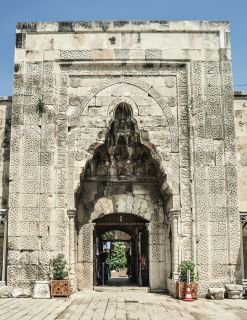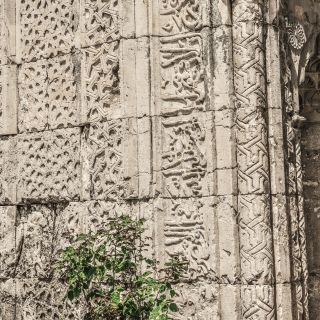DÜNDAR BEY MADRASA
Turkiye ISPARTA 14th Century
1301/02
It is located in Cami neighbourhood of Eğirdir district and locally known as Taş, i.e. Stone Madrasa.
It adjoins the city walls from outside and stands on a southeast-northwest oriented rectangular area; it is currently a single-story monument with an open courtyard and a single iwan.
The portal is on the southeast façade and it is flanked with a slit window. The northeast façade adjoining the fortification and the southwest façade facing the main street are both blind. The door in the middle of the northwest façade is a new addition as the structure is used as a shopping centre today.
The main southeast façade of the madrasa faces the northwest façade of the Hızır Bey mosque, aka Great Mosque; the portal protrudes out as a rectangular mass and it is known that it actually belonged to the Eğirdir Han commissioned by Sultan Giyath al-Din Kay Husraw II in 1237/38 and was brought here later.
The low-arched doorway of the portal leads into the vestibule which opens into the open courtyard, which is surrounded on three sides with pointed-arched porticoes resting on marble columns and covered with a pointed barrel vault.
On the northeast and southwest sides of the courtyard are three rooms each; rectangular rooms are covered with a pointed barrel vault. The vestibule is also flanked with two rectangular rooms covered with a pointed barrel vault. Narrow and long corridor-like rooms at the north and east corners of the courtyard were built to house the stairways leading to the non-extant upper floor.
The main iwan covered with a pointed barrel vault on the northwest side is flanked with two interconnected rectangular rooms.
In the centre of the courtyard is a square pool.
The madrasa was built with rubble and cut stones as well as spoliated materials. Marble columns of the courtyard porticoes are also spolia.
The iwan’s arch features a band of geometric and floral decoration. It is reported that the porticoes of the upper floor, not extant any more, had tiles.
The monument has been restored various times by the General Directorate of Pious Foundations and at the present it is used as a shopping centre.
The thuluth inscription over the main iwan’s arch states that it was built in 1301/02 by Falak al-Din Dundar Bey, the founder of the Hamidid Emirate.



